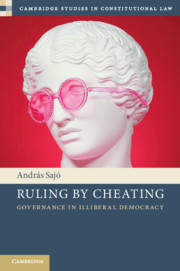Book contents
- Ruling by Cheating
- Cambridge Studies In Constitutional Law
- Ruling by Cheating
- Copyright page
- Contents
- Acknowledgments
- Abbreviations
- Introduction
- 1 Placing Illiberal Democracy
- 2 The Emergence of the Illiberal State
- 3 Creating Dependence
- 4 They, the People
- 5 Constitutional Structure
- 6 The Fate of Human Rights
- 7 Profiting from the Rule of Law
- 8 Cheating
- Index
1 - Placing Illiberal Democracy
Caesarism, Totalitarian Democracy, and Unfinished Constitutionalism
Published online by Cambridge University Press: 07 August 2021
- Ruling by Cheating
- Cambridge Studies In Constitutional Law
- Ruling by Cheating
- Copyright page
- Contents
- Acknowledgments
- Abbreviations
- Introduction
- 1 Placing Illiberal Democracy
- 2 The Emergence of the Illiberal State
- 3 Creating Dependence
- 4 They, the People
- 5 Constitutional Structure
- 6 The Fate of Human Rights
- 7 Profiting from the Rule of Law
- 8 Cheating
- Index
Summary
Illiberal governments claim that their regimes are simply constitutional and democratic - period. In their line of offense/defense, they are as democratic and constitutional as any other, only more popular and therefore more genuine. The term illiberal democracy is not an oxymoron. The regimes in Venezuela under Chávez, Hungary after 2010, or Poland from 2015 are indeed democracies, but in the plebiscitarian leader democracy sense, as described by Max Weber (with clear despotic potential). Illiberal democracies are democracies of a troubling sort, enabling the totalitarian potential inherent in mass democracy. Illiberal democracies bring to light the authoritarian elements in liberal constitutions, which are historically unfinished and internally vulnerable. The illiberal (authoritarian) elements (enclaves) that inevitably exist in constitutional systems are unleashed in the constitutional order of the plebiscitarian regimes. The illiberal transformation of constitutionalism is facilitated by the authoritarianism inherent in the constitutional order of established democracies and by the populist mobilization of authoritarian predispositions in the citizenry.
- Type
- Chapter
- Information
- Ruling by CheatingGovernance in Illiberal Democracy, pp. 18 - 55Publisher: Cambridge University PressPrint publication year: 2021



